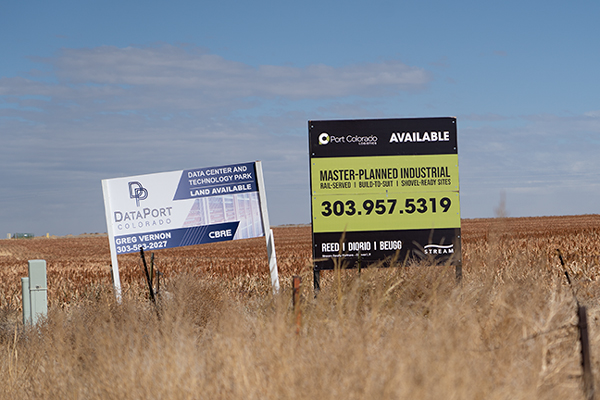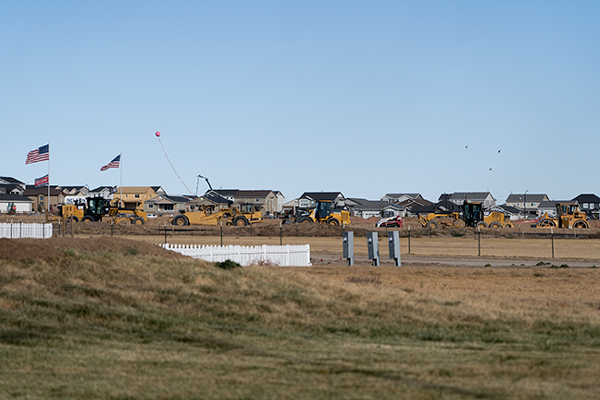
About four years ago, late Aurora Mayor Steve Ho
gan encouraged residents to look toward the sunrise to properly understand what the city may look like in the decades to come.
“If you want to see some of the areas with the biggest opportunities in Aurora, go east, my friends,” Hogan, who died following a cancer diagnosis three years ago, said during his final state of the city speech in 2017.
The city is named after the Roman goddess of dawn, after all — a fact Hogan was often quick to point out to lifers and tourists alike.
Now, a pandemic and a new cohort of civic leadership later, Hogan’s vision for a bustling burg on the eastern plains is beginning to bear fruit, and lots of it.
A veritable cornucopia of developments, from road improvements to hulking warehouses to meticulously planned communities expected to draw tens of thousands of people to the state’s third-largest city in the coming decades, are currently popping up in the city’s northeastern pocket. It’s a sector that for more than a decade has billed itself as a forthcoming “aerotropolis” thanks to a residential and commercial ecosystem bolted to Denver International Airport and the Colorado Air and Space Port in Watkins.
“Despite the pandemic, we’re seeing a lot of development activity on the east side of Aurora,” said Andrea Amonick, manager of the city’s development services division.
A catalogue of opportunities
There were 777 development applications on file with the city’s planning department as of last month, with some of the largest and most consequential proposals anchored to the area east of E-470 and north of Interstate 70. About 200 of those applications have been filed for projects just in the city’s northeastern sector in the past two years, data shows. In total, there are now more than 1,200 licensed businesses in Aurora east of E-470, an expanse that for decades was home to more prairie dogs than people.
Just last week, the Aurora City Council gave the green light to annex more than 1,400 acres of land outside of Watkins for the first phase of the so-called TransPort Colorado project, a 6,500-acre, massive, rail, commerce and logistics hub. At the same meeting, the council agreed to rezone the Gateway Park development, paving the way for more transit-oriented projects along East 40th Avenue.
With several other large distribution and manufacturing outposts in the region, including those tethered to the likes of Amazon, Walmart and the sprawling Porteos development, the new rail hub could ready the region to turn into a so-called inland port, according to Councilmember Dave Gruber.
“Inland ports in 2020 are similar to the railroad in 1890 — if you have one, you have one, if you don’t all that commerce can pass you by,” he said. “ … Ten or 20 years from now you’re going to be driving in Aurora and you’ll have an inland port with huge jobs through manufacturing and logistics, and there will be housing. This whole area is going to light up.”
Gruber, who has been a city council appointee to the Aerotropolis Regional Transportation Authority for the past several years, also pointed to the slew of upcoming road improvement projects powered by some $440 million of investment from ARTA, congressional dollars created to offset pandemic economic woes. Among the new ribbons of road are a new overpass atop E-470 at the intersection with East 38th Avenue, a new overpass on I-70 expected to be dubbed Aerotropolis Parkway, and a major extension of Picadilly Road.
“Now when you look at northeast Aurora, you’ve framed it on the west side with Picadilly and E-470, and on the eastern side you’ve got Aerotropolis Parkway,” said Gruber, who is not seeking re-election to his at-large post this November. “ … In the next five years, you’ll be able to drive from the Gaylord straight down one road, make a left on Jackson Gap and you’ll be at the airport.”
The new arterials and highway lanes will provide the much-needed infrastructure to make the eastern portion of the metro area, from Commerce City to the eastern stretches of Arapahoe County, a logistical cerberus via rail, trucking and air. For decades, Aurora planners have had the land, but only meager means to get people out there.
“People have been buying up land in the northeast for a long time and working on plans,” Amonick said. “The problem is when you build on the outskirts, the infrastructure hasn’t had an opportunity to reach out there yet. Now it begins to make sense for people to begin actually building out here and begin to extend the infrastructure required.”
It can hardly come fast enough. Industrial space in the northeast portion of the city is being gobbled up almost as fast as construction crews can stand it up, according to officials with the Aurora Economic Development Council.
There is currently about 3.1 million square feet of industrial space under construction in the city — almost all of it in Ward II — which is up 68% from the amount of space being created at the same time last year, according to Jonathan Woodward, director of development with AEDC.
Those new projects are moving ahead as the city’s industrial vacancy rate is down about 3 percentage points compared to the same time last fall, and another 4 million square feet of industrial deals are waiting to be inked.
“If it was 1 million square feet we’d get over the course of a year, we were happy with that a decade ago,” said Yuriy Gorlov, vice president of AEDC. “That it’s now four times that I think is a pretty powerful statement to what our market has become.”
In his recent state of the city address, Mayor Mike Coffman estimated that Aurora now claims more than 40% of the industrial market across the metroplex.

Big plans for getting bigger
And with those newfound manufacturing jobs come people who need places to live, supermarkets to frequent and schools to attend. City planners are steeling for waves of new Aurora residents to flock to the city in the coming decades thanks to a bevy of new housing developments, including Aurora Highlands, High Point, Painted Prairie and the recently announced Windler development near the intersection of East 56th Avenue and E-470. The latter project is expected to bring 5,000 new homes, millions of square feet of commercial space, hundreds of new hotel rooms and more than 50 acres of parks to the sector in the next decade.
Since Jan. 1, 2020, more than 1,100 single-family home construction permits have been sought just in Aurora’s northeastern quadrant, which translates to roughly everything east of I-225 and north of East Colfax Avenue, a city spokesperson confirmed. A half-dozen major developments ringing E-470 account for the bulk of the builds.
And unlike some of its neighbors to the south and west, Aurora has the water to sustain such rapid growth, according to city officials.
“The forward-thinking acquisition of water and land to the east has allowed us to grow,” Amonick said.
Aurora water managers have long said that the city is set to provide water to tens of thousands of additional residents — the current population is teetering toward 400,000 people, according to the latest estimates — for at least another half century. Some projections have shown that the city could need more than 40 billion gallons of water a year by 2070, more than double the usage in 2015.
For decades, Aurora officials have been picking up coveted water rights across the state, from Park to Eagle County, often to the chagrin of locals. Plans for another reservoir outside of Minturn are continuing to ruffle political feathers in 2021.
“This is one of the great secrets: How powerful and successful Aurora has been in obtaining water,” Gruber said.

Photo by PHILIP B. POSTON/Sentinel Colorado
Expanding politics
But Gruber’s seat is one of five up for grabs this Election Day, and four are guaranteed to turn over due to vacancies, term limits and pledges to step away from politics altogether.
The city could be on the precipice of a new political tide, including in Ward II where the bulk of the city dirt is currently being turned.
Former Ward II representative Nicole Johnston stepped down from her post earlier this year, setting off months of bitter infighting on the dais that stalled the most mundane proposals from moving forward even as development was roaring ahead in the region that was previously under Johnston’s charge.
“They’ll say the same thing that I will say: All you had to do was change one vote,” Gruber said of the months of political stasis. “They didn’t change, and we didn’t change, and that was the deadlock.”
For months, council members willfully violated the city charter when they couldn’t agree on who should be appointed to carry out the rest of Johnston’s term. Partisan factions created an impasse over the two applicants: Ryan Ross, a Democratic community college administrator, and Steve Sundberg, a Republican bar and grill owner.
On Nov. 2, Sundberg is still vying to nab the seat that represents Aurora’s largest council ward by acreage, covering much of the city east of Interstate 225 and north of East Hampden Avenue. The jurisdiction stretches nearly to the eastern border with Bennett.
It’s where the bulk of the bulldozers and cranes and steel beams coming into the city continue to be schlepped as a new frontier of Aurora continues to take shape.
“Aurora has planned for this for a long time,” Amonick said. “It’s just that the population and the demand has caught up with us.”

"along" - Google News
October 22, 2021 at 12:30AM
https://ift.tt/3vAqHQd
EASTERN EDEN: Growth along plains propels Aurora into regional spotlight - Sentinel Colorado
"along" - Google News
https://ift.tt/2z4LAdj
https://ift.tt/35rGyU8
Bagikan Berita Ini















0 Response to "EASTERN EDEN: Growth along plains propels Aurora into regional spotlight - Sentinel Colorado"
Post a Comment